小学英语一般疑问句讲义修订版
小学英语 一般疑问句

小学英语讲义一般疑问句一般疑问句一般疑问句:它是指用yes或no来回答的句子。
其结构是:系动词be/助动词/情态动词+主语+其他成分?一、含有be动词的陈述句转化为一般疑问句1、be 动词提前,主语第一人称改为第二人称,句号改问号,读升调。
2、my变成your our变成yourI am / We are 变Are you3、注意人名不论放在什么位置都要大写如 Tom is a student.Is Tom a student?4、一般疑问句翻译成汉语都有"吗"?例如 1)This is my English teacher.Is this your English teacher? 这是你的英语老师吗?肯定回答 Yes,it is. 否定回答 No,it isn’t.(注意:主语为单数的指示代词如this,that,应该用it替代。
主语为复数的指示代词如 these,those,应该用they替代。
) 2)It is our school.Is it your school? 它是你的学校吗?肯定回答 Yes,it is. 否定回答 No,it isn’t.3)We are students.Are you students? 你们是学生吗?肯定回答 Yes,we are. 否定回答 No,we aren’t.4) I am a student.Are you a student?你是学生吗?肯定回答 Yes,I am. 否定回答 No,I am not.(注意:一般疑问句有时也不用yes和no回答。
)相应练习一、将下列陈述句变为一般疑问句。
1、she is a doctor.(用肯定回答)________________________________________________________________________2、I am a boy.________________________________________________________________________3、we are students.(用否定回答)________________________________________________________________________4、He is my father.________________________________________________________________________二、含有情态动词(can,may,should……)的陈述句转化为一般疑问句。
小学英语一般疑问句PPT课件
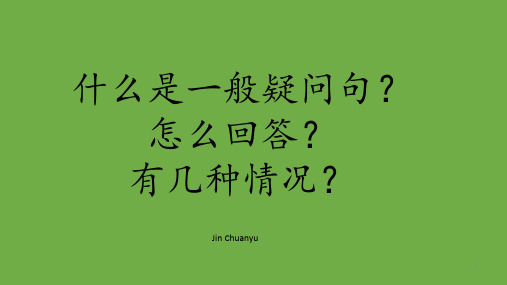
1. ___________________________________?
Yes, there is a bookstore next to the school.
2. ____________________________________?
Yes, there are some pandas in the mountains.
Do you go to bed at nine o’clock?
.
4
5 I will go back in two days.
Will you go back in two days?
6 He can play football. Can he play football?
7 The children are singing.
1 be动词: am, is, are, was, were
2 情态动词: can, may,will,must ,shall,should,could, might, would,need, …
3 助动词: do does did has/have(已经)
注意:
some在否定句, 疑问句中 要变成 any
4. Can your mother play the pipa?
No, _______ _______.
5 .May I have a look?
_____, ______ ______ ______(肯. 定)
9
二、根据图片回答问题.
1Are you watching TV? _________________.
2.Is he short and strong? ___________________.
小学英语语法详解疑问句-选择疑问句、特殊疑问句、一般疑问句、否定句、
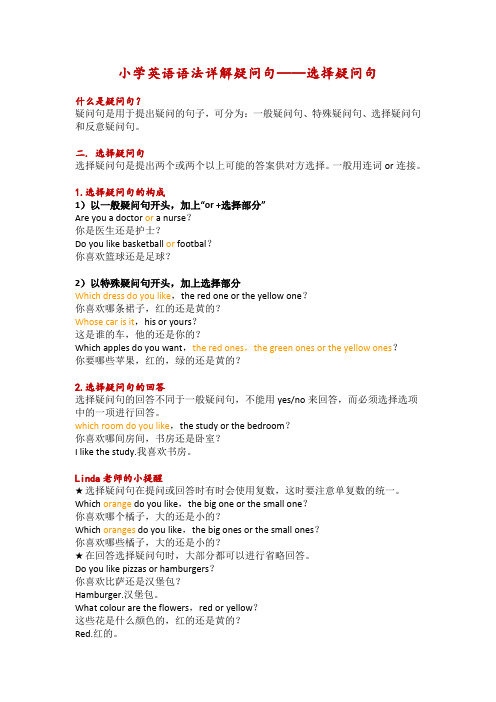
什么是疑问句?疑问句是用于提出疑问的句子,可分为:一般疑问句、特殊疑问句、选择疑问句和反意疑问句。
二. 选择疑问句选择疑问句是提出两个或两个以上可能的答案供对方选择。
一般用连词or连接。
1.选择疑问句的构成1)以一般疑问句开头,加上“or +选择部分”Are you a doctor or a nurse?你是医生还是护士?Do you like basketball or footbal?你喜欢篮球还是足球?2)以特殊疑问句开头,加上选择部分Which dress do you like,the red one or the yellow one?你喜欢哪条裙子,红的还是黄的?Whose car is it,his or yours?这是谁的车,他的还是你的?Which apples do you want,the red ones,the green ones or the yellow ones?你要哪些苹果,红的,绿的还是黄的?2.选择疑问句的回答选择疑问句的回答不同于一般疑问句,不能用yes/no来回答,而必须选择选项中的一项进行回答。
which room do you like,the study or the bedroom?你喜欢哪间房间,书房还是卧室?I like the study.我喜欢书房。
Linda老师的小提醒★选择疑问句在提问或回答时有时会使用复数,这时要注意单复数的统一。
Which orange do you like,the big one or the small one?你喜欢哪个橘子,大的还是小的?Which oranges do you like,the big ones or the small ones?你喜欢哪些橘子,大的还是小的?★在回答选择疑问句时,大部分都可以进行省略回答。
Do you like pizzas or hamburgers?你喜欢比萨还是汉堡包?Hamburger.汉堡包。
小学英语肯定句、否定句、一般疑问句和特殊疑问句地详解
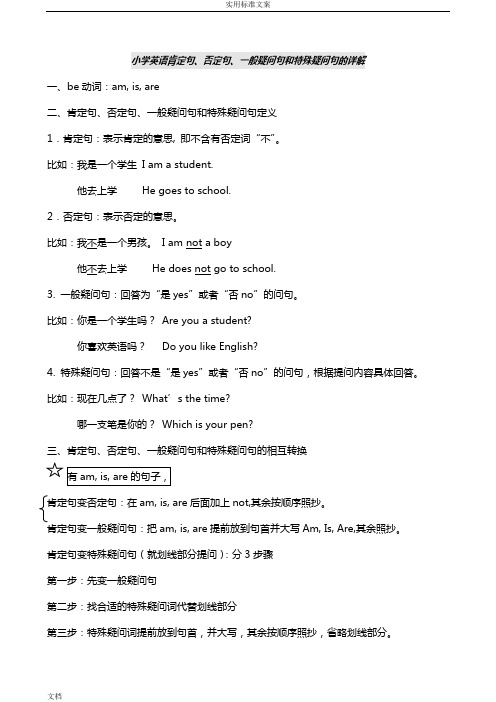
小学英语肯定句、否定句、一般疑问句和特殊疑问句的详解一、be动词:am, is, are二、肯定句、否定句、一般疑问句和特殊疑问句定义1.肯定句:表示肯定的意思, 即不含有否定词“不”。
比如:我是一个学生I am a student.他去上学He goes to school.2.否定句:表示否定的意思。
比如:我不是一个男孩。
I am not a boy他不去上学He does not go to school.3. 一般疑问句:回答为“是yes”或者“否no”的问句。
比如:你是一个学生吗?Are you a student?你喜欢英语吗?Do you like English?4. 特殊疑问句:回答不是“是yes”或者“否no”的问句,根据提问内容具体回答。
比如:现在几点了?What’s the time?哪一支笔是你的?Which is your pen?三、肯定句、否定句、一般疑问句和特殊疑问句的相互转换肯定句变否定句:在am, is, are后面加上not,其余按顺序照抄。
am, is, are提前放到句首并大写Am, Is, Are,其余照抄。
肯定句变特殊疑问句(就划线部分提问):分3步骤第一步:先变一般疑问句第二步:找合适的特殊疑问词代替划线部分第三步:特殊疑问词提前放到句首,并大写,其余按顺序照抄,省略划线部分。
注意:1.如:Li ming 's not here today. Who's not here today? 今天谁没来?2.划线部分不能在特殊疑问句中出现。
例如:1.肯定句、否定句和一般疑问句的互换肯定句:This is a book.否定句:一般疑问句:Is this a book?肯定回答:Yes, it is.否定回答:No, it isn’t.2.就划线部分提问(变特殊疑问句)This is a book.第一步:变一般疑问句Is this a book?第二步:找合适的特殊疑问词Is this what ?第三步:特殊疑问词提前放到句首,并大写,其余按顺序照抄,省略划线部分。
小学四年级英语考点之一般疑问句及特殊疑问句

句⼦基本是:简单陈述句,由简单陈述句转变成肯定句,否定句,疑问句。
疑问句是⽤来提出问题。
英语中有四种疑问句: ⼀般疑问句、特殊疑问句、选择疑问句和反意疑问句。
我们现在已经接触到了前两种疑问句。
后两种疑问句以后我们还会学到.⼀般疑问句: 英语中要⽤ yes和no 来回答的疑问句叫⼀般疑问句。
如: 1)Is it hot ?Yes, it is .\No, it isn’t.—— be动词引导 2)Is it a car ?Yes, it is .\No, it isn’t .—— be动词引导 3)Is this your ruler ?Yes, it is .\No, it isn’t .—— be动词引导 4)Do you like bananas ?——含实义动词 Yes, I like bananas. \ No, I don’t like bananas. 5)Can Ming hear a drill ?——含情态动词 Yes , Ming can hear a drill.\No,Ming can’t hear a drill. .陈述句(肯定句,否定句,⼀般疑问句)的转变规律: 1.肯定句:2.否定句:3. ⼀般疑问句及肯否定回答 1) 主语+be动词+….1) 主语+be动词+not+….1)be动词+主语+…? Yes,主语+be动词./ No,主语+be动词+not. I am a teacher. I amnot a teacher.Are you a teacher? --Yes, I am./ No, I am not. My mother is thin. My mother is not /isn’t thin.Is your mother thin? --Yes, she is./ No, she isn’t. They areinsects. They are not/aren’t insects.Are they insects? --Yes. they are./ No, they aren’t. 2) 主语+情态动词can+… 2) 主语+情态动词can+ not+….2)情态动词can+主语+…? Yes,主语+情态动词can/ No,主语+情态动词can+ not He can jump. He cannot/can’tjump.Can he jump? --Yes,he can./ No, he can’t. 3)助动词do/does+主语+…. 动词原形+….动词原形? Yes,主语+助动词do/does. No,主语+助动词do/does+not. He likes to eat apples. He doesn’t like to eat apples. Does he like to eat apples? Yes,he does./ No,he doesn’t.。
小学英语语法一般疑问句和特殊疑问句PPT课件

2、如句子里是动词就在这些词前加 don't,doesn't,didn't
(1)主语是第一、二人称(复数)加don’t,第三人称单数加
doesn't
(2)如果是过去式就加didn't
例:I like dogs.
She likes swimming.
I don‘t like dogs.
She doesn’t like swimming.
A How B Where C What D Who
3.A: Was this book in the desk?
B: ___D____
A Yes,it is. B No,it was C Yes,it wasn’t D No,it wasn’t
4.A: ____A___ heavy is John?
Thank You !
e.g经营者提供商品或者服务有欺诈行为的,应当按照消费者的要求增加赔偿其受到的损失,增加赔偿的金额为消费者购买商品的价款或接受服务的费用
This is Amy's bike.(一般疑问句) Is this Amy's bike? Yes, this is. (肯定回答) No, this isn't. (否定回答) Did you go to Beijing last weekend? Yes, I did. (肯定回答) No, I didn't. (否定回答) I have some books. (一般疑问句) Do you have any books?
特殊疑问句
表示疑问,有疑问词(在开头),回答有很
多种可能。
常用疑问词:
When 什么时间 (问时间)
(完整版)小学英语一般疑问句、否定句和特殊疑问(附习题)(可编辑修改word版)
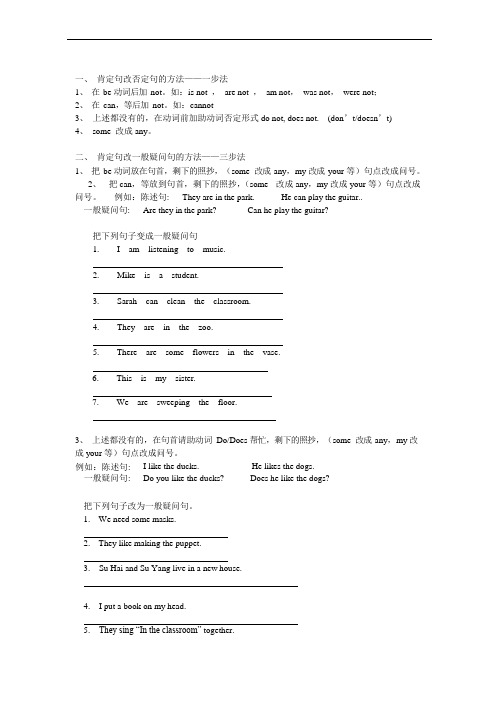
一、肯定句改否定句的方法——一步法1、在be 动词后加not。
如:is not ,are not ,am not,was not,were not;2、在can,等后加not。
如:cannot3、上述都没有的,在动词前加助动词否定形式do not, does not. (don’t/doesn’t)4、some 改成any。
二、肯定句改一般疑问句的方法——三步法1、把be 动词放在句首,剩下的照抄,(some 改成any,my 改成your 等)句点改成问号。
2、把can,等放到句首,剩下的照抄,(some 改成any,my 改成your 等)句点改成问号。
例如:陈述句: They are in the park. He can play the guitar..一般疑问句: Are they in the park? Can he play the guitar?把下列句子变成一般疑问句1. I am listening to music.2. Mike is a student.3. Sarah can clean the classroom.4. They are in the zoo.5. There are some flowers in the vase.6.This is my sister.7.We are sweeping the floor.3、上述都没有的,在句首请助动词Do/Does 帮忙,剩下的照抄,(some 改成any,my 改成your 等)句点改成问号。
例如:陈述句: I like the ducks. He likes the dogs.一般疑问句: Do you like the ducks? Does he like the dogs?把下列句子改为一般疑问句。
1.We need some masks.2.They like making the puppet.3.Su Hai and Su Yang live in a new house.4.I put a book on my head.5.They sing “In the classroom” together.6.We play basketball on Sundays.7.Tom likes listening to music三、肯定句改特殊疑问句的方法——四步法1、在一般疑问句的基础上,句首添加一个疑问词即可,可根据划线部分确定是什么疑问词。
小学英语 变一般疑问句详细讲解课件
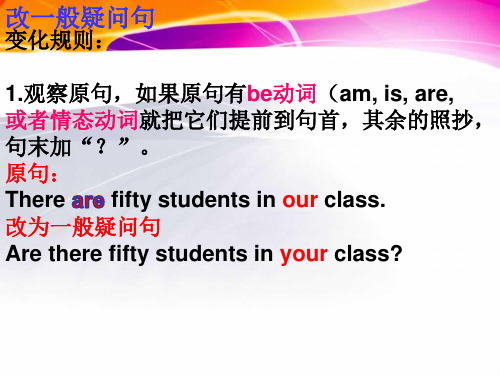
some 和any意思都是:一些 但是用法有区别。 some 用在肯定句,any用在否定句和疑问句。
There are some books in my bag.(肯定句) There are not any books in my bag.(否定句) Are there any books in your bag? (疑问句)
(5) Amy likes pears.
D_o__e_sAmy l_i_k_e_ ____ pears ?
改一般疑问句
变化规则:
2.如果句中没有be动词就用Do或Does。(动词是 原形用Do;动词是第三人称单数用Does; 原句: We like music. 改为一般疑问句 Do you like music? 原句 He likes art. 改为一般疑问句 Does he like art?
3.注意:改句时,第一人称改为第二人称:I am 改为 Are you; We are 改为 Are you; some改为any; do、does、后的动词改为原形。 句尾加问号。
把下列句子改为一般疑问句。
(1)I am a good student.
_A_r_e____ __y_o__u__ a good student?
(2) He can swim.
__C__a_n_____ __h__e______ swim?
(3) ngling _l_ik_e___ apples?
改一般疑问句
变化规则:
1.观察原句,如果原句有be动词(am, is, are, 或者情态动词就把它们提前到句首,其余的照抄, 句末加“?”。 原句: There fifty students in our class. 改为一般疑问句 Are there fifty students in your class?
小学英语一般疑问句讲解PPT课件
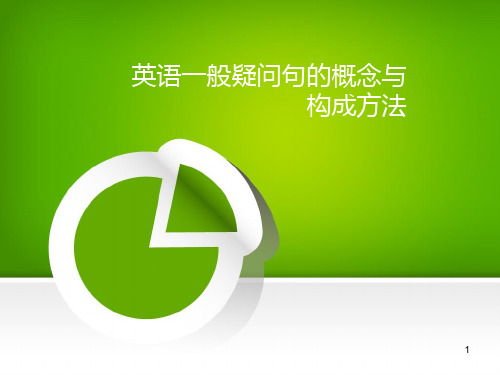
一、选择正确的单词填空
(who, where, when) 1._____ is that pretty girl? She is my sister. 2._____ are Jack and Tom? They are behind you. 3._____ do you go to school? I go to school from Monday to Friday. 4._____ has a beautiful flower? John has a beautiful flower. 5._____ are they? They are my parents. 6._____ is my mother? She is in the living room. 7._____ are you going? We are going to the bakery(面包坊). 8._____ do Jim and Wendy play ball? They play ball in the afternoon. 9._____ does he jog? He jogs in the park. 10._____ are you from? I'm from Changchun city.
Do your parents like English? 肯答: Yes,they do. 否答: No,they don’t.
10
五、如何将陈述句变为一般疑问句?
1、第一家族:含be动词或情态动词的句子 秘诀:一调二改三问号 一调:即把句中的be或情态动词调到主语前; 二改:改换主语称谓,即将句中的主语I\my \we\our等第
肯定回答用“Yes,主语+情态动词”, 否定回答用“No,主语+情态动词.”
小学英语语法一般疑问句和特殊疑问句
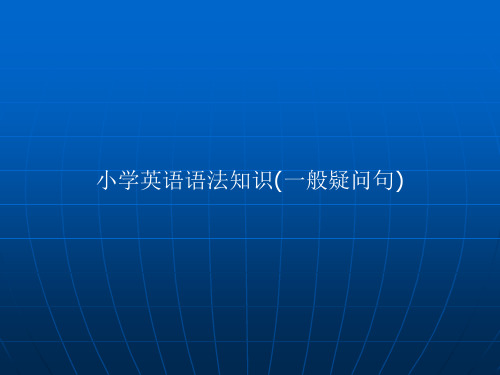
(2)确定助动词用do、does还是did,根据句中动 词,动词是原形的助动词就用do,动词是第三人称 单数的助动词就用does,动词用过去式的助动词就 有did。 (3)把助动词后提到句首。 (4)原句中动词假如发生变化就要恢复成原形。 强调一点,有some的要考虑是否要用any。
小学英语语法知识(一般疑问句)
一般疑问句:
表示疑问,一般回答只有两种可能Yes,……或 No,……句中没有疑问词。
如何将一个肯定的陈述句改为否定句:
1、看句中有无be动词,如有,把be动词提到句首即 可。
2、看句中有无情态动词,上述二者都没有,就应把助动提到句首。分四 个步骤:
特殊疑问句
表示疑问,有疑问词(在开头),回答有很多种可能。 常用疑问词: When 什么时间 问时间 What time 什么时间 问具体时间,如几点钟 Who 谁 问人 Whose 谁的 问主人 Where 在哪里 问地点 Which 哪一个 问选择 Why 为什么 问原因 What 什么 问东西、事物 What colour 什么颜色 问颜色 What about 。。。。怎么样 问意见 What day 星期几 问星期几
就划线部分提问:(变特殊疑问句) This is a book. 第一步:变一般疑问句
Is this a book? 第二步:找合适的特殊疑问词
Is this what ? 第三步:特殊疑问词提前放到句首,并大写, 其余按顺序照抄,省略划线部分。
What is this?
变否定句的做法:
1、如句子里是be动词:am,is,are,was,were 就在这些词后加
小学英语一般疑问句

小学英语讲义一般疑问句一般疑问句一般疑问句:它是指用yes或no来回答的句子。
其结构是:系动词be/助动词/情态动词+主语+其他成分?一、含有be动词的陈述句转化为一般疑问句1、be 动词提前,主语第一人称改为第二人称,句号改问号,读升调。
2、my变成yourour变成yourI am / We are 变Are you3、注意人名不论放在什么位置都要大写如 Tom is a student.Is Tom a student?4、一般疑问句翻译成汉语都有"吗"?例如1)This is my English teacher.Is this your English teacher? 这是你的英语老师吗?肯定回答 Yes,it is. 否定回答 No,it isn’t.(注意:主语为单数的指示代词如this,that,应该用it替代。
主语为复数的指示代词如 these,those,应该用they替代。
)2)It is our school.Is it your school? 它是你的学校吗?肯定回答 Yes,it is. 否定回答 No,it isn’t.3)We are students. Are you students? 你们是学生吗?肯定回答 Yes,we are. 否定回答 No,we aren’t.4) I am a student.Are you a student?你是学生吗?肯定回答 Yes,I am. 否定回答 No,I am not.(注意:一般疑问句有时也不用yes和no回答。
)相应练习一、将下列陈述句变为一般疑问句。
1、she is a doctor.(用肯定回答)________________________________________________________________________2、I am a boy.________________________________________________________________________3、we are students.(用否定回答)________________________________________________________________________4、He is my father.________________________________________________________________________二、含有情态动词(can,may,should……)的陈述句转化为一般疑问句。
小学英语肯定句变一般疑问句ppt课件

肯定回答:__Y_e_s__, __I _a_m_____ 否定回答:__N__o__, __I _‘m__n_o_t__
4. She is looking for her dog. __Is___ she __l_o_o_k_in__g__ for her dog?
“雪亮工程"是以区(县)、乡(镇) 、村( 社区) 三级综 治中心 为指挥 平台、 以综治 信息化 为支撑 、以网 格化管 理为基 础、以 公共安 全视频 监控联 网应用 为重点 的“群 众性治 安防控 工程” 。
中文解释什么是一般疑问句
1.你吃饭了吗?
肯定回答: 是的,我吃了
2.他睡觉了吗?
否定回答: 不,他没睡
2. She has to clean the classroom every day. _D_o_es__ she _h_a_v_e_ to clean the classroom every day?
肯定回答:__Y_e_s___, _s_h_e__d_o_es___ 否定回答:__N_o____, _s_h_e_d_o_e_s_n_’t_
否定回答:__N_o___, __I _d_o_n_’t____
4. We did morning exercises yesterday. _D__id__ you __d_o__ morning exercises yesterday?
肯定回答:_Y_e_s___, _w__e_d_i_d____ 否定回答:__N_o___, _w__e__d_id_n_’_t_
_W__e_r_e_ there _a_n_y___ birds in the tree two days ago?
小学英语语法:陈述句变一般疑问句
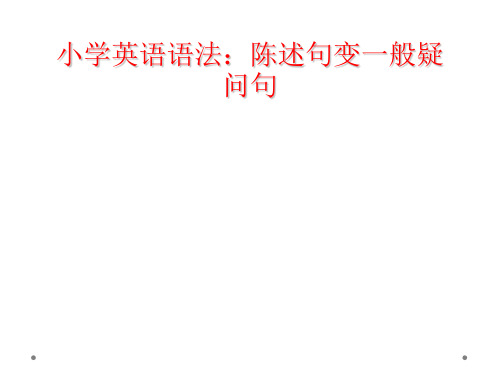
肯定句
一般疑问句
Yes , it is.
1. This is a ruler. Is_t_h_is_a_r_u_le_r_?__N_o_,_it isn’t.
2. Xu Chang is in grade 4.
_Is_X_u_C_h_an_g_i_n _gr_ad_e_4_?
Jim is six.
Yes, he is. 肯定回答
Is Jim six?
No, he isn’t.否定回答
肯定句
一般疑问句
They are kind. I am happy. We are friends.
Are they kind?
肯定回答:Yes, they are. 否定回答:No, they aren’t.
Yes , she can.
2. Mary can skip.Can M_ar_y_sk_ip_?__N_o_,_sh_e_c_a_n’t.
3. They will go shopping.
_W_ill_t_he_y_g_o_sh_o_p_p_in_g?_
Yes , they will. No, they won’t.
4. I can dance.
Yes , I can.
__Ca_n_y_o_u_d_a_n_ce_?__N_o, I can’t.
如何将一个肯定的陈述句改为一般疑问句
秘诀一:找be动词或情态动词
看句中有无be动词或情态动词,如 有,把be动词或情态动词提到句首 即可。
如果原句子没有be动词也没有情态 动词,
❖ 例1: I can sing songs. ❖ Step1由情态动词引导的一般疑问句: Can … ❖ Step2: Can you… ❖ Step3: Can you sing songs?
小学英语语法——一般疑问句
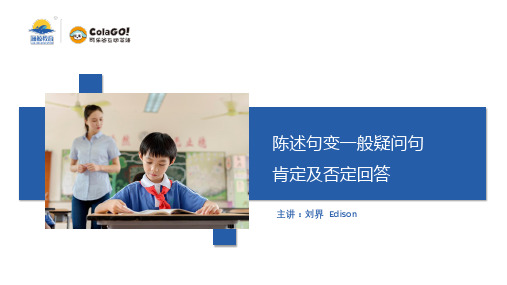
03.I am a student. 一般疑问句就是: Are you a student? 肯定回答:Yes, I am. 否定回答:No, I’m not. 04.We can help you. 一般疑问句就是: Can we help you? 肯定回答:Yes, we can. 否定回答:No, we can’t.
08.He can play basketball.
Can he play basketball?
肯定回答:Yes, he can.
否定回答:No, he can’t.
09. He is crying under the tree.
Is he crying under the tree?
肯定回答:Yes, he is.
如果主语是I或是we的,一般疑问句一般情况下要把人 称改为you。反之you要改成I,we,me或us。
01.His father is an English teacher.
Is his father an English teacher?
肯定回答:Yes, he is.
பைடு நூலகம்
否定回答: No, he isn’t.
02.They can swim. Can they swim?
肯定回答:Yes, they can. 否定回答: No, they can’t.
03.She is Jim’s mother.
Is she Jim’s mother?
肯定回答:Yes, she is.
否定回答: No, she isn’t.
陈述句变一般疑问句 肯定及否定回答
主讲:刘界 Edison
陈述句变为一般疑问句,首先看句中有没有系动词be或情态动词,如 果有,把be或情态动词直接提到句首就可以了;如果没有,要用助动 词do 或does 来帮助。基本句式如下: Be + 主语 +宾语 + 其他 + ? 情态动词 + 主语 + 谓语 + 宾语 + 其他 + ? Do(Does + 主语 + 谓语 + 宾语 + 其他 + ?
小学英语语法- 一般疑问句VS特殊疑问句-讲练结合

1. Do you like music?
2. Is it wonderful? 3. Can you play the violin? 4. Are they happy?
秘诀是: 用什么问就用什么答。
5. Is the shadow long?
6. Does Peter have any orange juice?
变化秘诀: 1.判断。 2.移动或添加。
三、如何改一般疑问句?
1.判断。判断是否有Be动词或情态动词。
2.有就移动。把Be动词和情态动词移至句首。
3.无就添加Do/Does。 原句谓语是动原,添Do 原句谓语是三单,添Does
温馨提示: 1.加了助动词就要用回动原; 2.第一人称要变第二人称;
3. some 变any
2. 以情态动词(can)开头
e.g. Can you play the piano?
3. 以助动词(do/does)开头
e.g. (1) Do you like playing the violin? (2) Does Jill like playing the guitar?
三、如何改一般疑问句?
B:They are behind you. 10.A:_________ is his hair? B: It's yellow.
Goodbye!
四、一般疑问句的回答
秘诀是:用什么问就用什么答。
结构为:
Yes,___1 ___ ____2____. No, ___1___ ___3_____.
1只能是人称代词主格(I/you/we/he/she/it/they)和there, 根据主语作判定。 2和3就根据一般疑问句用什么问就用什么答,2是肯定,3是否定。
小学英语语法---一般疑问句和特殊疑问句
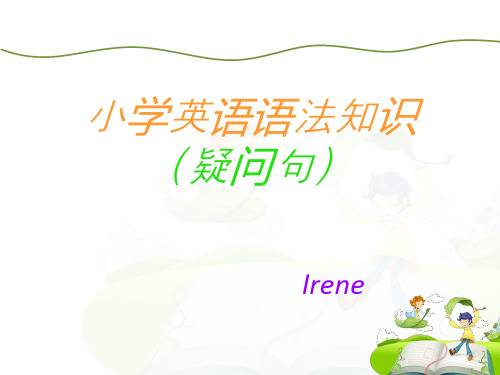
Did …………?
助动词
Does ………… ?
Can ………… ? 情态动词
一般疑问句的回答只能用Yes或No.
一般疑问句:
表示疑问,一般回答只有两种可能Yes,……或 No,……句中没有疑问词。
如何将一个肯定的陈述句改为否定句:
1、看句中有无be动词,如有,把be动词提到句首即 可。be动词(is 、are、was、were)
Thank You !
Mike: My father.
A How B Where C What D Who
3.A: Was this book in the desk?
B: ___D____
A Yes,it is. B No,it was C Yes,it wasn’t D No,it wasn’t
4.A: ____A___ heavy is John?
2、看句中有无情态动词,如有,把情态动词提到句首 即可。 情态动词(can)
3、如上述二者都没有,就应把助动提到句首。 助动词(do、did、 does)
分四个步骤:
(1)肯定陈述句中本来是没有助动词的,要加上去, 位置在主语(某人或某物)后,动词前。
(2)确定助动词用do、does还是did,根据句中动 词,动词是原形的助动词就用do,动词是第三人称单 数的助动词就用does,动词用过去式的助动词就有 did。 (3)把助动词后提到句首。 (4)原句中动词假如发生变化就要恢复成原形。 强调一点,有some的要考虑是否要用any。
Exercises :针对下列划线部分提问
1.We are going to Hainan. Where are you going to ? 2.Amy goes to Shanghai in February. When does Amy go to Shanghai? 3.Kitty is wearing a special costume. Who is wearing a special costume? 4.I go to school by bike. How do you go to school? 5.I like summer. Which season do you like best? 6.My name is John. What is your name.
小学英语一般疑问句讲义
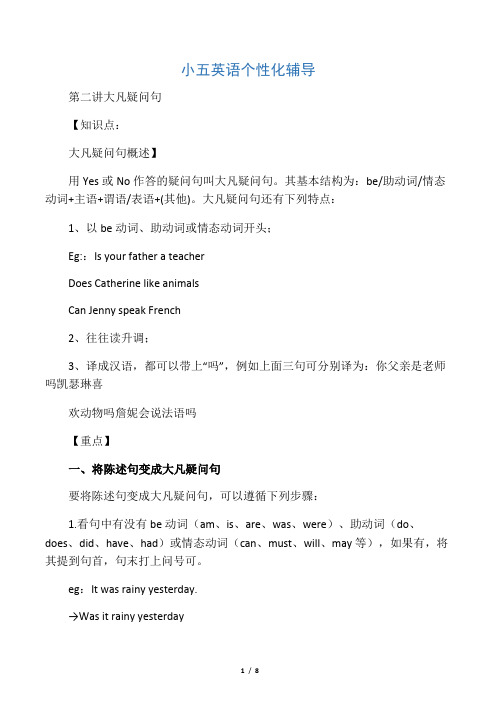
小五英语个性化辅导第二讲大凡疑问句【知识点:大凡疑问句概述】用Yes或No作答的疑问句叫大凡疑问句。
其基本结构为:be/助动词/情态动词+主语+谓语/表语+(其他)。
大凡疑问句还有下列特点:1、以be动词、助动词或情态动词开头;Eg::Is your father a teacherDoes Catherine like animalsCan Jenny speak French2、往往读升调;3、译成汉语,都可以带上“吗”,例如上面三句可分别译为:你父亲是老师吗凯瑟琳喜欢动物吗詹妮会说法语吗【重点】一、将陈述句变成大凡疑问句要将陈述句变成大凡疑问句,可以遵循下列步骤:1.看句中有没有be动词(am、is、are、was、were)、助动词(do、does、did、have、had)或情态动词(can、must、will、may等),如果有,将其提到句首,句末打上问号可。
eg:It was rainy yesterday.→Wa s it rainy yesterdayTom“s father can play the piano.→Can Tom“s father play the pianoI have finished my homework.→Have you finished your homework2.如果句中没有be动词、助动词或情态动词,则根据谓语动词的形式借助do的相应形式放在句首。
具体方法是:如果谓语动词是原形,则借do;如果谓语动词是大凡现在时第三人称单数形式,则借does;如果谓语动词是过去式,则借did.需要注意的是,借does或did后,原句的谓语动词要变回原形。
例:They go to school by bike.→Do they go to school by bikeBill gets up at 6:30 every day.→Does bill gets up at 6:30 every dayThe students saw a film yesterday.→Did the students see a film yesterday二、大凡疑问句的回答大凡疑问句往往采用简短回答,共由三部分(三个单词)组成,对这三部分(三个单词)的确定可以概括例下:1.第一个词:不是Yes就是No。
小学英语肯定句否定句一般疑问句和特殊疑问句的详解
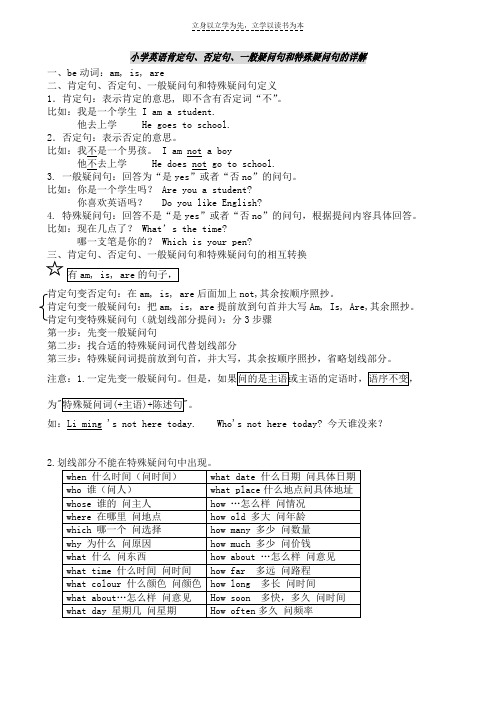
小学英语肯定句、否定句、一般疑问句和特殊疑问句的详解一、be动词:am, is, are二、肯定句、否定句、一般疑问句和特殊疑问句定义1.肯定句:表示肯定的意思, 即不含有否定词“不”。
比如:我是一个学生 I am a student.他去上学 He goes to school.2.否定句:表示否定的意思。
比如:我不是一个男孩。
I am not a boy他不去上学 He does not go to school.3. 一般疑问句:回答为“是yes”或者“否no”的问句。
比如:你是一个学生吗? Are you a student?你喜欢英语吗? Do you like English?4. 特殊疑问句:回答不是“是yes”或者“否no”的问句,根据提问内容具体回答。
比如:现在几点了? What’s the time?哪一支笔是你的? Which is your pen?肯定句变否定句:在am, is, are后面加上not,其余按顺序照抄。
肯定句变一般疑问句:把am, is, are提前放到句首并大写Am, Is, Are,其余照抄。
肯定句变特殊疑问句(就划线部分提问):分3步骤第一步:先变一般疑问句第二步:找合适的特殊疑问词代替划线部分第三步:特殊疑问词提前放到句首,并大写,其余按顺序照抄,省略划线部分。
注意:1.如:Li ming 's not here today. Who's not here today? 今天谁没来?2.例如:1.肯定句、否定句和一般疑问句的互换肯定句:This is a book.否定句:一般疑问句:Is this a book?肯定回答:Yes, it is.否定回答:No, it isn’t.2.就划线部分提问(变特殊疑问句)This is a book.第一步:变一般疑问句 Is this a book?第二步:找合适的特殊疑问词 Is this what ?特殊疑问词提前放到句首,并大写,其余按顺序照抄,省略划线部分。
- 1、下载文档前请自行甄别文档内容的完整性,平台不提供额外的编辑、内容补充、找答案等附加服务。
- 2、"仅部分预览"的文档,不可在线预览部分如存在完整性等问题,可反馈申请退款(可完整预览的文档不适用该条件!)。
- 3、如文档侵犯您的权益,请联系客服反馈,我们会尽快为您处理(人工客服工作时间:9:00-18:30)。
小学英语一般疑问句讲义Company number:【WTUT-WT88Y-W8BBGB-BWYTT-19998】小五英语个性化辅导第二讲一般疑问句【知识点:一般疑问句概述】用Yes或No作答的疑问句叫一般疑问句。
其基本结构为:be/助动词/情态动词+主语+谓语/表语+(其他) 。
一般疑问句还有下列特点:1、以be动词、助动词或情态动词开头;Eg::Is your father a teacherDoes Catherine like animalsCan Jenny speak French2、往往读升调;3、译成汉语,都可以带上“吗”,例如上面三句可分别译为:你父亲是老师吗凯瑟琳喜欢动物吗詹妮会说法语吗【重点】一、将陈述句变成一般疑问句要将陈述句变成一般疑问句,可以遵循下列步骤:1.看句中有没有be动词(am、is、 are、 was、 were)、助动词(do、does、did、have、 had)或情态动词(can、must、will、may等),如果有,将其提到句首,句末打上问号可。
eg:It was rainy yesterday.→Was it rainy yesterdayTom's father can play the piano.→Can Tom's father play the pianoI have finished my homework.→Have you finished your homework2.如果句中没有be动词、助动词或情态动词,则根据谓语动词的形式借助do的相应形式放在句首。
具体方法是:如果谓语动词是原形,则借do;如果谓语动词是一般现在时第三人称单数形式,则借does;如果谓语动词是过去式,则借did. 需要注意的是,借does或did后,原句的谓语动词要变回原形。
例:They go to school by bike.→Do they go to school by bikeBill gets up at 6:30 every day.→Does bill gets up at 6:30 every dayThe students saw a film yesterday.→Did the students see a film yesterday二、一般疑问句的回答一般疑问句往往采用简短回答,共由三部分(三个单词)组成,对这三部分(三个单词)的确定可以概括例下:1.第一个词:不是Yes就是No。
(有时根据语气的不同,Yes可由Sure, Certainly, Of course,no 可用never,not at all等代替)eg: (1)—Can you help me你能帮个忙吗—Certainly.当然。
(2)—Have you been there你到过那里吗—Never.从来没有。
2.第二个词:问谁答谁。
即答语中的主语须与问句的主语一致(但必须用主格代词)。
eg:Does she clean her room every day Yes, she does.Is Anna′s father a doctor No,he isn′t.如果主语是 this that,回答时用 it 代替,如果问句中主语these, those,回答时用 they代替。
3.第三个词:用什么问,用什么答。
即沿用问句中的引导词。
Can Jim play soccer Yes, he can.Does Mr Bean speak English Yes, he does.需要注意问题:用 may 引导的问句,肯定回答用may,否定回答用can′t 或mustn′t,用must 引导的问句,肯定回答用 must,否定回答用needn′t.eg:May I go to the park now Yes, you may. /No, you mustn′t.Must I wash my clothes now Yes, you must. /No, you needn′t.4.用No开头作否定回答时,结尾要加上 not。
因为回答必须是三部分,所以否定回答必须缩写,而肯定回答不能缩写。
eg:Did Thomas come here yesterday Yes, he did./ No ,he didn′t.Is Lin Lin in Class 3 Yes, she is. / No, she isn′t.或(No, she′s not).【难点】一、陈述句变一般疑问句应注意的事项陈述句变成一般疑问句除了遵循上述规则以外,还应注意下列几点:1.如果陈述句中有第一人称,则变问句时最好要变为第二人称。
eg:I usually have lunch at school.→Do you usually have lunch at schoolMy father is playing soccer.→Is your father playing soccer2.如果陈述句中有some, 则变问句时往往要变成any 。
Eg: There is some water on the playground.→Is there any water on the playground3.复合句变一般疑问句通常只变主句,从句不变。
eg:I know he comes from Canada.→Do you know he comes from Canada4.如果句中含有实义动词have且表示“有”时,除借do外,也可将其直接提到句首。
Eg:I have some friends in America.→Have you any friends in America/Do you have any friends in America二、一般疑问句的否定式(1)一般疑问句的否定式,一般结构为系动词/助动词/情态动词+not+主语;也可为系动词/助动词/情态动词+主语+not,Do you not/Don’t you believe me 你不相信我Is it not / Isn’t it a lovely day 天气难道不好吗Are you not / Aren’t you coming你不来吗Will you not /Won’t you sit down 你不坐会儿吗Is he not / Isn’t he a doctor 他不是医生吗Does Helen not /Doesn’t Helen like chocolat e 海伦不喜欢巧克力吗Will he not /Won’t he go with you他不和你一块儿去吗(2)否定疑问句并不单纯表示提问,它常常带有感情色彩。
否定疑问句的完全式比简略式所表达的语气更强烈些。
1)否定疑问句常常带有惊异、赞叹或责难等语气,如:Haven’t you read the newspaper你没读过这份报纸呀Won’t he come他不来了2)否定疑问句有时暗示提问者期待着肯定的回答,如:Shouldn’t we start now我们现在是不是该动身了Was n’t it an interesting film那部电影是不是很有趣3)否定疑问句有时用来表示邀请或建议,如:Wouldn’t you like to go with me你不想和我一块儿去吗Won’t you have a cup of coffee你不喝杯咖啡吗(3)否定的一般疑问句的答语中,yes的含义为“不”,no的含义为“是”,但在回答这类句子时,应该注意yes后接肯定结构,no后接否定结构,这和汉语习惯不同,如:—Are you not Mr Smith你不是史密斯先生吗—Yes,Iam.不,我是。
/—No,I am not.是的,我不是。
—Haven’t you read this book before 你从前没有读过这本书吗—Yes,I have.不,我读过。
/—No,I haven’t.是的,我没有。
—Don’tyou play chess你不下棋吗—Yes ,I do.不,我下棋。
/—No,I don’t.是的,我不下棋。
教你一招:在这样的答语中,只要根据实际情况来判断,如果事实上是,就要用yes;如果事实上不是,就要用no。
A: Don’t you come from EnglandB: come from America.A. No, I doB. Yes, I doC. Yes, I don’tD. No, I don’t 【实战演练】1. His father is an English teacher.2. These cats are crying.3. They can swim.4. I like to read English.5. I go to school on foot.6. His father goes to work by bus.7. His birthday is on the twentieth of November.8. Mrs. Li and Kitty are in a big shop.9. Kitty is wearing her new uniform.10. I want to have a model car.11. She wants a cup of coffee.12. Mrs. Li and Kitty watch television at night.13. I do my homework after school.【强化练习】陈述句变一般疑问句1. Everybody is in the classroom._________________________________________2. The boy does some housework(家庭作业) at home._________________________________________3. The children had a good time in the park(公园)._________________________________________4. Jim has some story-books. (故事书)_________________________________________5. The old man does morning exercises(早操) every morning. _________________________________________6. We are from China._________________________________________7. He often goes to the library(图书馆) on Sundays._________________________________________8. They have a class meeting every week.________________________________________9. She does ___10. He often watches11. There is no problem about it. ________________________________________12. My father likes play13. There are 5 students in the14. He has some15. They have Chinese16. Tom has few17. My parents can play tennis________________________________________18. He is watering the flowers in the19. This is my20. These are my家长签字:教师评语:。
